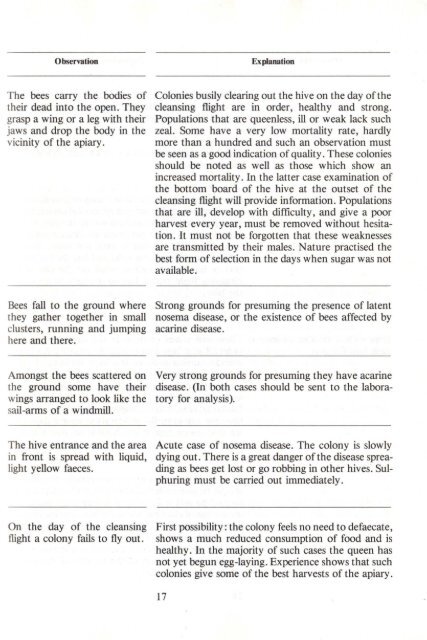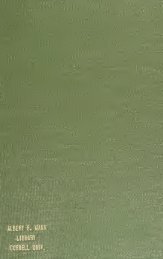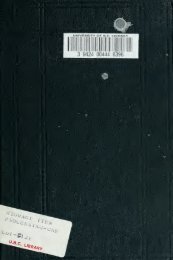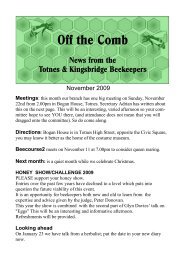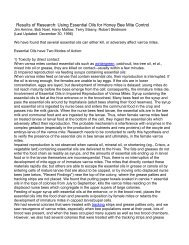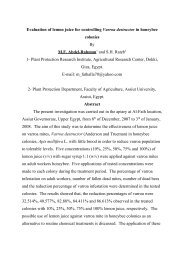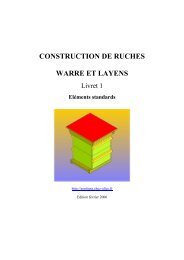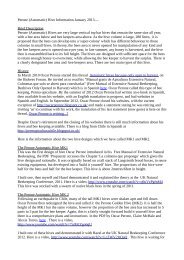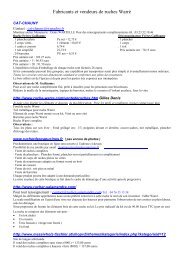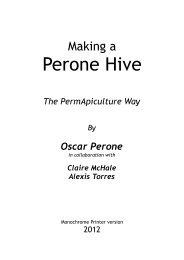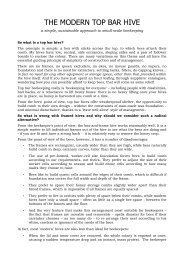You also want an ePaper? Increase the reach of your titles
YUMPU automatically turns print PDFs into web optimized ePapers that Google loves.
Observation<br />
Explanation<br />
The bees carry <strong>the</strong> bodies of<br />
<strong>the</strong>ir dead into <strong>the</strong> open. They<br />
grasp a wing or a leg with <strong>the</strong>ir<br />
jaws and drop <strong>the</strong> body in <strong>the</strong><br />
vicinity of <strong>the</strong> apiary.<br />
Colonies busily clearing out <strong>the</strong> hive on <strong>the</strong> day of <strong>the</strong><br />
cleansing flight are in order, healthy and strong.<br />
Populations that are queenless, ill or weak lack such<br />
zeal. Some have a very low mortality rate, hardly<br />
more than a hundred and such an observation must<br />
be seen as a good indication of quality. These colonies<br />
should be noted as well as those which show an<br />
increased mortality. In <strong>the</strong> latter case examination of<br />
<strong>the</strong> bottom board of <strong>the</strong> hive at <strong>the</strong> outset of <strong>the</strong><br />
cleansing flight will provide information. Populations<br />
that are ill, develop with difficulty, and give a poor<br />
harvest every year, must be removed without hesitation.<br />
It must not be forgotten that <strong>the</strong>se weaknesses<br />
are transmitted by <strong>the</strong>ir males. Nature practised <strong>the</strong><br />
best form of selection in <strong>the</strong> days when sugar was not<br />
available.<br />
Bees fall to <strong>the</strong> ground where<br />
<strong>the</strong>y ga<strong>the</strong>r toge<strong>the</strong>r in small<br />
clusters, running and jumping<br />
here and <strong>the</strong>re.<br />
Strong grounds for presuming <strong>the</strong> presence of latent<br />
nosema disease, or <strong>the</strong> existence of bees affected by<br />
acarine disease.<br />
Amongst <strong>the</strong> bees scattered on<br />
<strong>the</strong> ground some have <strong>the</strong>ir<br />
wings arranged to look like <strong>the</strong><br />
sail-arms of a windmill.<br />
Very strong grounds for presuming <strong>the</strong>y have acarine<br />
disease. (In both cases should be sent to <strong>the</strong> laboratory<br />
for analysis).<br />
The hive entrance and <strong>the</strong> area<br />
in front is spread with liquid,<br />
light yellow faeces.<br />
Acute case of nosema disease. The colony is slowly<br />
dying out. There is a great danger of <strong>the</strong> disease spreading<br />
as bees get lost or go robbing in o<strong>the</strong>r hives. Sulphuring<br />
must be carried out immediately.<br />
On <strong>the</strong> day of <strong>the</strong> cleansing<br />
flight a colony fails to fly out.<br />
First possibility: <strong>the</strong> colony feels no need to defaecate,<br />
shows a much reduced consumption of food and is<br />
healthy. In <strong>the</strong> majority of such cases <strong>the</strong> queen has<br />
not yet begun egg-laying. Experience shows that such<br />
colonies give some of <strong>the</strong> best harvests of <strong>the</strong> apiary.<br />
17


